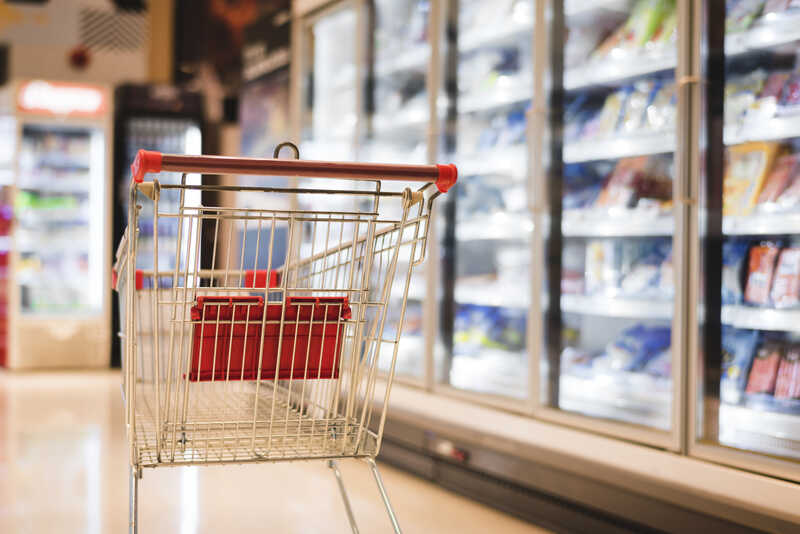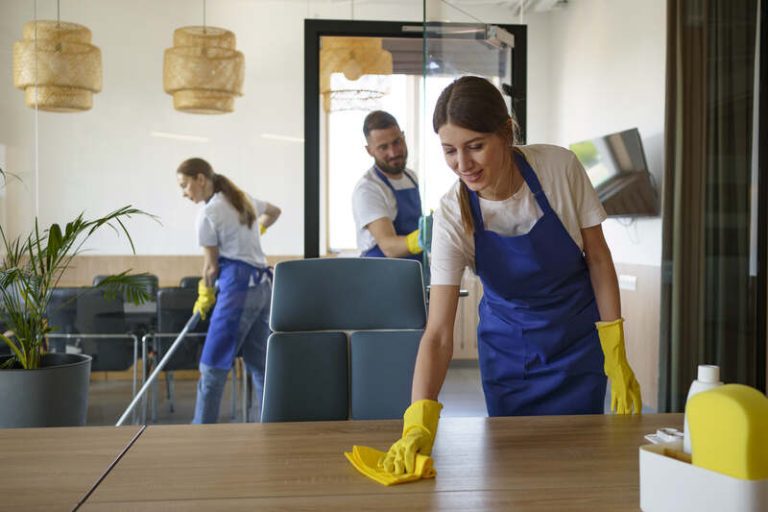Keeping a retail store clean is essential to creating a welcoming and safe environment for customers and employees. That’s why, as an owner, you should know the retail store cleaning guide. It’s not just about how to clean retail store, but it also includes a retail store cleaning checklist.
Don’t worry, in this article, we will dissect what is included in the retail store daily cleaning checklist, as well as detailed weekly, and monthly checklists for retail store owners and managers to ensure their stores are always in top condition.
Let’s dive into the retail store cleaning guide and take note of the retail shop cleaning checklist to keep your retail space clean and organised.
Daily Cleaning Checklist for Retail Store
A daily cleaning checklist helps manage routine cleaning tasks by ensuring that high-traffic areas and frequently touched surfaces are cleaned and disinfected regularly. Here is the full list:
a. Entrance and Front Area
Ensuring that these areas are clean and well-maintained is essential to provide a welcoming environment that reflects the brand’s image.
This involves regular sweeping to keep the floors free of dust and debris, mopping to maintain cleanliness, and thorough glass cleaning to ensure a clear view into the shop. In addition, dusting surfaces, organizing displays, and keeping the area clutter-free are also important tasks to enhance the overall appearance.
b. Sales Floor
The sales floor, where customers interact with products, must be kept clean and well-maintained to enhance the shopping experience.
To ensure a pristine environment, dusting shelves and product displays regularly is essential. Keeping the products neatly arranged not only aids in maintaining order but also enhances the visual appeal for customers.
Wiping down surfaces and thoroughly cleaning any spills or smudges is crucial to creating a welcoming atmosphere. When the sales floor is clean, customers feel more comfortable and confident in their shopping experience, leading to increased customer satisfaction.
c. Fitting Rooms
Changing rooms are high-touch areas that require regular cleaning to ensure a pleasant experience for customers.
Tasks involved in cleaning changing rooms include sanitising all surfaces to prevent the spread of germs and ensuring that mirrors are streak-free for customers to try on clothing with ease.
Maintaining the tidiness of changing rooms after each use is crucial, which involves organising clothing items, folding them neatly, and returning any discarded items to their respective racks or shelves.
d. Restrooms
Maintaining hygiene in restrooms is critical, as these areas require thorough cleaning and disinfecting to prevent the spread of germs.
One crucial aspect of upkeeping restroom cleanliness is the usage of appropriate cleaning products that are effective against common pathogens. The correct cleaning solutions and disinfectants help eliminate harmful bacteria and viruses, creating a safer environment for everyone.
Regular inspections play a vital role in ensuring that cleaning protocols are followed consistently. By conducting routine checks, facilities can address any cleanliness issues promptly and uphold high hygiene standards..
e. Break Room/Kitchen Area
The staff room and kitchen area must be kept clean to ensure a hygienic environment for employees to relax and eat.
Regular cleaning tasks in these areas should include:
- wiping down all surfaces, such as tables, worktops, and cupboards, to remove any dirt or food residue.
- cleaning appliances like the microwave, fridge, and coffee machine to prevent the build-up of germs.
- emptying and sanitizing rubbish bins on a daily basis to help maintain a fresh and pleasant space for staff.
f. Stock Room
Keeping the stock room organised and clean ensures that products are easy to find and in good condition.
One of the key tasks involved in maintaining the stock room is organising products in a systematic way to optimise space and facilitate quick retrieval. Additionally, dusting shelves regularly is essential to uphold hygiene standards and prevent any build-up of dirt or grime.
Ensuring the area is clutter-free not only enhances the overall appearance but also contributes to efficient stock management. By eliminating obstacles and maintaining a tidy environment, staff can work more effectively and accurately track inventory levels.
g. Checkout Area
The checkout area, being a high-touch zone, requires frequent cleaning to ensure a pleasant and hygienic customer service experience.
Regular cleaning and sanitisation of the checkout area is crucial not only for maintaining a positive impression on customers but also for upholding health and safety standards. Clean counters, cash registers, and payment terminals not only enhance the overall look of the shop but also reduce the risk of spreading germs and bacteria.
Weekly Cleaning Checklist for Retail Store
A weekly cleaning checklist enables more comprehensive cleaning tasks that surpass daily maintenance, ensuring a consistently spotless environment. Below is the full list:
a. Dusting and Wiping Down Shelves and Displays
Dusting and wiping down shelves and displays are essential to keep products looking their best and free from dust accumulation.
Regarding dusting and wiping down shelves and displays, it’s crucial to choose the right cleaning tools and products. Soft microfibre cloths or dusters are perfect for delicate surfaces, ensuring that dust is lifted gently without causing any damage. For tougher stains or sticky residues, a mild cleaning solution diluted in water can help get the job done effectively.
b. Vacuuming and Mopping Floors
Regular vacuuming and mopping of floors help maintain cleanliness and prevent dirt buildup in high-traffic areas.
Clean floors not only enhance the overall aesthetics of the shop but also contribute to a healthier environment for both customers and employees. A well-maintained floor reflects positively on the professionalism and attention to detail of the business, creating a welcoming atmosphere for visitors.
Choosing the right tools and techniques is crucial for efficiently cleaning different types of flooring. For carpets, a powerful vacuum with appropriate attachments can effectively remove dirt and debris. Hardwood or laminate floors may require gentle mopping with a microfiber mop to avoid damage.
c. Cleaning Windows and Glass Surfaces
Cleaning windows and glass surfaces enhances the shop’s appearance and ensures a clear, inviting view for customers.
To achieve streak-free results, start by choosing the right tools and products. Begin by dusting off any dirt or debris from the windows using a soft brush or cloth. Next, mix a solution of warm water and a small amount of washing-up liquid in a bucket.
Use a squeegee to apply the solution to the windows, working from top to bottom in overlapping strokes. Dry the windows with a clean, lint-free cloth or newspaper to prevent streaks.
d. Disinfecting High-Touch Surfaces
Disinfecting high-touch surfaces is crucial to reduce the risk of disease transmission and maintain a hygienic environment.
When we regularly disinfect surfaces that are frequently touched, such as door handles and checkouts, we effectively eliminate harmful germs and bacteria that could potentially spread illness. These high-touch areas serve as breeding grounds for pathogens, highlighting the necessity of consistent cleaning practices.
By using appropriate cleaning products like disinfectant sprays or wipes containing antibacterial agents, we ensure that these surfaces are not only visibly clean but also safe from invisible threats.
e. Restocking Supplies
Restocking supplies ensures that cleaning staff always have the necessary equipment and products to maintain the shop’s cleanliness.
Knowing when to restock is crucial to avoid unexpected shortages that can disrupt the cleaning routine. Having a well-planned schedule for replenishing supplies helps in keeping the inventory organised and prevents last-minute rushes.
Regarding cleaning equipment, items like mop heads, vacuum bags, and scrubbing pads should be checked regularly and replaced as needed to ensure effective cleaning performance. Additionally, disinfectants and sanitizers play a vital role in maintaining a hygienic environment, so stocking up on these essentials is essential for promoting a healthy and safe workspace.
Monthly Cleaning Checklist for Retail Store
A monthly cleaning checklist focuses on deep cleaning and maintenance tasks that help preserve the shop’s pristine condition and extend the life of fixtures and equipment. Find out the full list below:
a. Deep Cleaning Carpets and Upholstery
Deep cleaning carpets and upholstery removes deep-seated dirt and stains, ensuring a fresh and inviting appearance.
One of the most effective methods used for deep cleaning carpets and upholstery is hot water extraction. This process involves injecting hot water mixed with cleaning solution deep into the fibres, followed by powerful suction to extract the dirt and grime.
Another common technique is dry cleaning, where specialised cleaning agents are applied and then worked into the fabric using a machine.
b. Cleaning and Organising Storage Areas
Cleaning and organising storage areas not only help in maintaining cleanliness but also ensure efficient management of products and supplies. One of the key tasks involved in cleaning and organising storage areas is sorting through all the products and supplies, ensuring that they are properly categorised based on type or usage. This makes it easier to locate items when needed, saving time and reducing clutter.
Another important step is dusting shelves, bins, and containers to keep the storage area free from dirt and allergens. It is crucial to ensure that items are stored in an orderly manner, with heavier or less frequently used items placed at lower levels for safety and convenience.
c. Checking and Replacing Light Bulbs
Regularly checking and replacing light bulbs is essential to maintain adequate lighting and ensure a pleasant shopping environment.
Proper lighting not only enhances the aesthetics of your store but also plays a crucial role in influencing customer behaviour and overall shopping experience. Dark or poorly lit areas can deter customers from browsing your products and may even pose safety hazards.
To ensure optimal lighting, it is important to conduct routine checks for any flickering or dim bulbs. Create a maintenance schedule to inspect all light fixtures, including overhead lights, track lighting, and display lights.
Keep an inventory of spare bulbs and necessary tools to quickly replace any faulty ones. Remember to follow safety precautions, such as turning off the power before changing bulbs, to prevent accidents.
d. Inspecting and Cleaning the HVAC System
Inspecting and cleaning the HVAC system ensures that the shop’s air quality remains high and the system operates efficiently.
Regular maintenance of the HVAC system is essential to prevent potential issues that could lead to costly repairs down the road. By replacing filters regularly, one can avoid the build-up of dust and debris that can obstruct airflow and reduce efficiency. Additionally, cleaning components such as coils and fans helps maintain optimal performance and prolong the lifespan of the system. Ignoring these maintenance tasks can not only compromise indoor air quality but also result in higher energy bills due to decreased efficiency.
e. Wiping Down and Dusting Ceiling Fans and Light Fixtures
Regular wiping down and dusting of ceiling fans and light fittings prevent dust accumulation and ensure a clean, well-maintained appearance.
For a more thorough cleaning process, it is essential to dismantle the fittings and fans before starting. This allows you to access all areas that need attention. Use a robust ladder to reach ceiling fans safely and ensure the power supply is turned off.
Begin by removing any light bulbs, lampshades, or casings for a more detailed clean. Dust and debris can settle in the crevices and corners, so a damp microfibre cloth or a soft-bristled brush can effectively remove buildup without causing damage.
Finally, here’s a complete retail store cleaning guide that can help you ensure the cleanliness of your store. From the daily, weekly, and monthly retail store cleaning list above, it can be seen that this is a complex task that requires more attention.
Maintaining the cleanliness of your retail store is crucial not just for aesthetic appeal, but also for the health and safety of your customers and staff. Given the complexity and importance of this task, it’s essential to rely on professional services.
TEKA Cleaning offers both commercial cleaning and specialised cleaning services tailored to meet your specific needs. Our expert team ensures that every corner of your store is spotless, providing a welcoming environment that enhances your store’s reputation and customer satisfaction.
Don’t compromise on cleanliness! Contact TEKA Cleaning today at 01233 751 544 to schedule your cleaning services and keep your retail space in pristine condition.
Read also:










